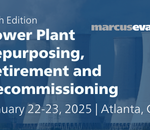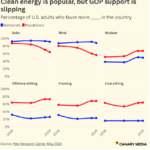Offshore wind in the U.S. finds itself in a difficult spot, with few projects underway and others facing major practical challenges. On top of those well-known existing hurdles, the election of Donald Trump has erected what could be a colossal obstacle.
At a campaign rally last May, The Guardian reported, Trump called wind turbines “horrible” and vowed, “We are going to make sure that that ends on day one. I’m going to write it out in an executive order. It’s going to end on day one.”
Trump’s ire over offshore wind goes back to a dispute started in 2006 while he was developing a golf course in Scotland. He objected to a nearby offshore windfarm, saying it was “ugly.” He said, “I want to see the ocean, I do not want to see windmills.” The dispute ended up in court, where Trump fought the wind project all the way to the U.K. Supreme Court. He lost.

Whether Trump acts as promised is unclear. He has often made hyperbolic claims that go unfulfilled. An executive order would face tough legal channels. The reality won’t be known for at least two months. But there may be reasons why the new president does not declare war on wind.
Not long after the election on Nov. 8, George Felcyn of the Washington law firm Bracewell scoped out what might temper the new administration’s views of watery wind. He offers “a couple of reasons to hold out hope for offshore wind in the next couple of years.”
The first reason Felcyn offers is union votes. “Union members have made no bones about their willingness to vote for Donald Trump, and the Republican Party has taken notice of this new dynamic. So one thing to remember here is that big offshore wind projects like building ports and staging and assembly facilities, all the big things you need to get those projects going, those are also big sources of union jobs, and union members want more industrial sized job opportunities, not fewer.”
The second reason for Felcyn’s wind optimism is “the growing need for electricity in the United States. Look around us. We see the rise of AI, the use of crypto currency, EVs, the generalized movement to electrification in homes and in the commercial sector, this means huge projected increases for energy demand in the US over the next couple of years.”
Felcyn suggests, “So, if I’m in the new Trump administration and I’m in charge of energy policy, I’m going to have a hard time overlooking the benefits of offshore wind as a potential resource that we all might need in a very serious way over the next four years and even beyond.”
Even if the day one threat fails to materialize, offshore wind will still face problems, according to Felcyn. First: leasing. “The Biden administration itself might have created the playbook here. When President Biden came in early in his administration and signed an executive order that suspended new lease sales for oil and gas on public lands and federal waters, leasing activity came to a halt. The issue eventually went to the courts, and it was a matter of some years before new oil and gas leases actually came to be. And we might expect some variation of that scenario in the Trump administration.”
Next: permitting. “Even in the best of times, the Interior Department has struggled to efficiently issue permits for the construction and operation plans that big offshore wind projects need to pivot from the planning and preparation stage to building out in earnest. Some strides have been made on that front within (Interior’s Bureau of Ocean Energy Management), but with the second Trump administration now coming to town, we’re likely to see some attrition from the federal agency bureaucrats that are in charge of those permitting reviews, coupled with a newfound focus within the Interior Department on getting oil and gas resources going once again, both offshore and on public lands. So, as a result, we can expect to see BOEM take its foot off the pedal when it comes to issuing offshore wind permits in a timely fashion.”
A recent study of the costs and benefits of offshore wind by the Washington-based environmental think tank Resources for the Future (RFF) said, “Electricity from offshore wind is considered important for reducing energy-related emissions because of its ability to serve coastal areas and complement other non-emitting electricity sources. However, there are open questions about the degree to which it will replace emitting versus other non-emitting generation, improve public health, and affect the total cost of the electricity supply.”
Overall, the RFF analysis found that offshore wind’s benefits exceeded its costs, by a wide margin. Whether Trump will pay attention or even care is a major question.
–Kennedy Maize
The Quad Report
To comment:
kenmaize@gmail.com





